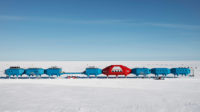Sarpy County, Nebraska
The Elkhorn River Research Station could be mistaken for a rusting vestige of the steamboat days, left to disintegrate on the riverbank about 30 miles west of Omaha, like so many other industrial cast-offs. Clad in overlapping, Cor-Ten steel panels, with an asymmetrical roof, the station looks like the prow of a ship, or, from afar, like a preserved slice of a covered bridge.
But this minuscule, 70-square-foot, wood-frame “probe,” as architect Randy Brown calls it, has a very modern function. It houses specimen tanks, water-testing equipment, and room for a few researchers to work.
You may have heard the frightening stories in the last decade: male fish and frogs exhibiting female traits because of water contamination caused by humans. Dr. Alan Kolok, an aquatic toxicologist at the University of Nebraska, focuses his research on such problems, studying “emerging contaminants”—molecules from birth-control pills, pesticides, fertilizer, and household-cleaning supplies, to name just some, that make their way into the water system and have disturbing effects on animals.
This work has taken Kolok all over Nebraska, searching for the signs and concentration of these toxins in the state's seven rivers. More recently, he decided to try to get the community to help him collect data. He discovered that if you give a Boy Scout troop or Kiwanis Club the simple tools needed to test water, they'll happily participate. “I'm really interested in community engagement and how we can empower citizens to be involved,” says Kolok. “And what better way to do it than a distinctive piece of architecture?”
Kolok and his team approached the Omaha-based Brown to design a pilot research station, the first of seven that are planned, one for each river. As a center for the public and the university, and a masthead for Kolok, the compact form serves as branding. “It's the segue—the entry point—into this fairly sophisticated educational outreach system we're developing,” says Kolok. Some of the more remote stations will have small living accommodations.
For Brown, who, like Marlon Blackwell in Arkansas and Brian MacKay-Lyons in Nova Scotia, has carved out a regional niche for himself, the project was a new challenge. “We didn't realize how tough it was going to be to build on the river,” he says. The Nebraska Natural Resources District has strict regulations. Structures must be above the 100-year floodplain and pilings cannot affect the rise or flow of the river, inspiring Brown to perch the station on thin steel tubes, which have minimal effect on the water level. A symbolic slit in the metal paneling marks the flood line.
Two ADA-compliant wood ramps lead to the entrance and brace the structure. Jutting out over the water, a small wood deck has a V-shaped steel nose and a metal seat for observation. While the placid water flowed well underneath the station on a recent early spring day, it can easily flood the riverbank after winters with heavy snows. The nose helps deflect blocks of ice and logs that may float down the river. So does one of the steel stilts, which leans at an angle and has springlike give. Slabs of limestone steps lead down to the water next to the station.
Brown says he convinced Kolok to make the station even smaller than the scientist had originally requested, mostly for cost reasons. The station's pilings had to be buried 40 feet, costing a third of the $150,000 construction budget. “The lack of a big budget forces you to be creative and to clarify your idea,” says Brown. “I think there's more of an experience here than in an office tower.”
The 45-year-old architect has scaled back his own practice since the economic downturn and is focusing now on “just the projects I want to do,” he says. These smaller designs provide immediate satisfaction and allow Brown to be less of an office manager.
Omaha was settled because of the confluence of its rivers, first by Native American tribes and then by members of the Lewis and Clark expedition. Docks provided the gateways to the river towns that developed subsequently. Today, Kolok is happy that his small metal station ties into the region's river culture, with its rusty, maritime aesthetic. “I think it resonates with people,” he says. “If you live here, and you drive by that river every day, you are interested.”
Completion Date: March 2012
Gross square footage: 63
Total construction cost: $149,000
People
Architect: Owner: University of Nebraska- Aquatic Toxicology Laboratory
Randy Brown FAIA lead designer Architect of record: Randy Brown Associate architect: George Killian, AIA Campus Architect
Engineer(s):
Bob Lapke, geo tech engineer
Mark Augustine, PE hydrology Engineer
General contractor: Todd Gaver
Photographer: CAD system, project management, or other software used: Rhino, Autocad |
ProductsStructural system - concrete pilings, structural steels columns, wood frame structure
Exterior cladding
Roofing
Glazing
Doors Floor and wall tile (cite where used): Fiberon Brand composite decking LightingExterior: compact fluorescents in stonco exterior lamp holders |





















